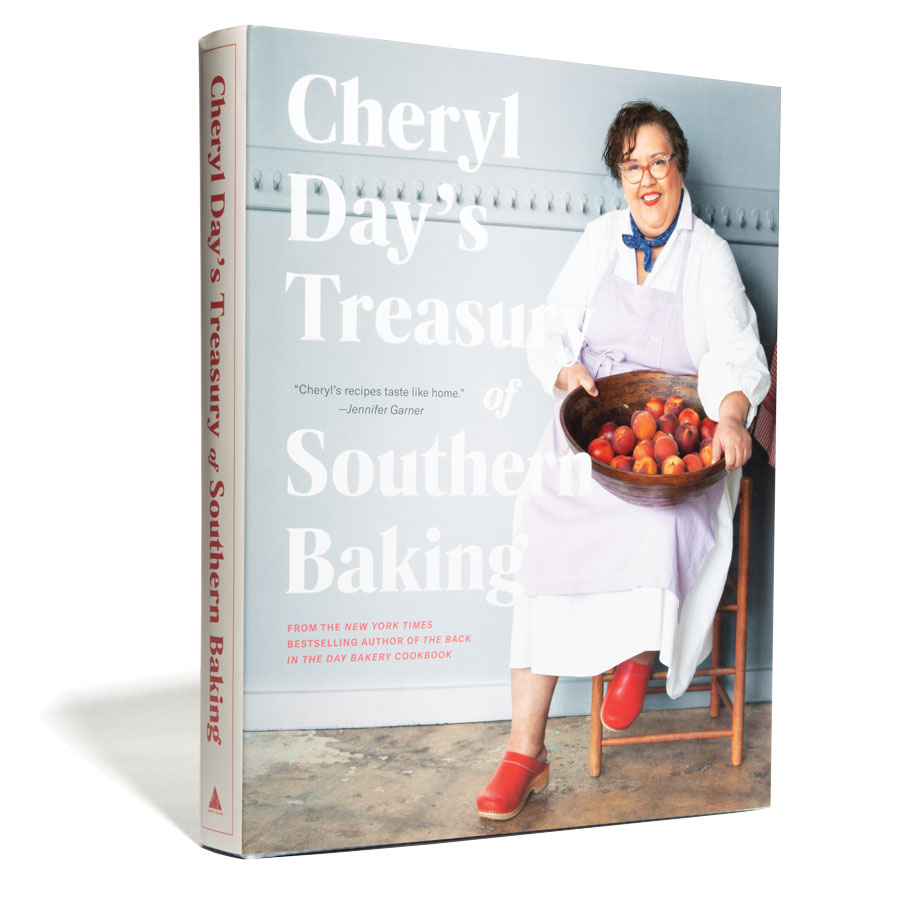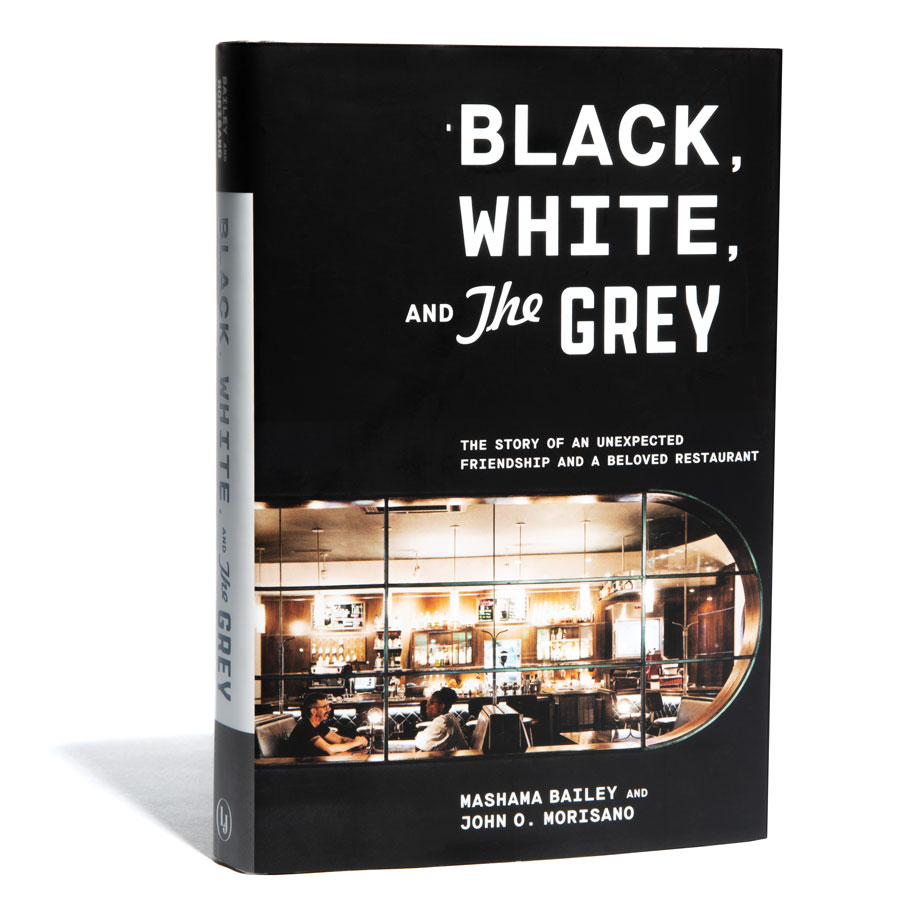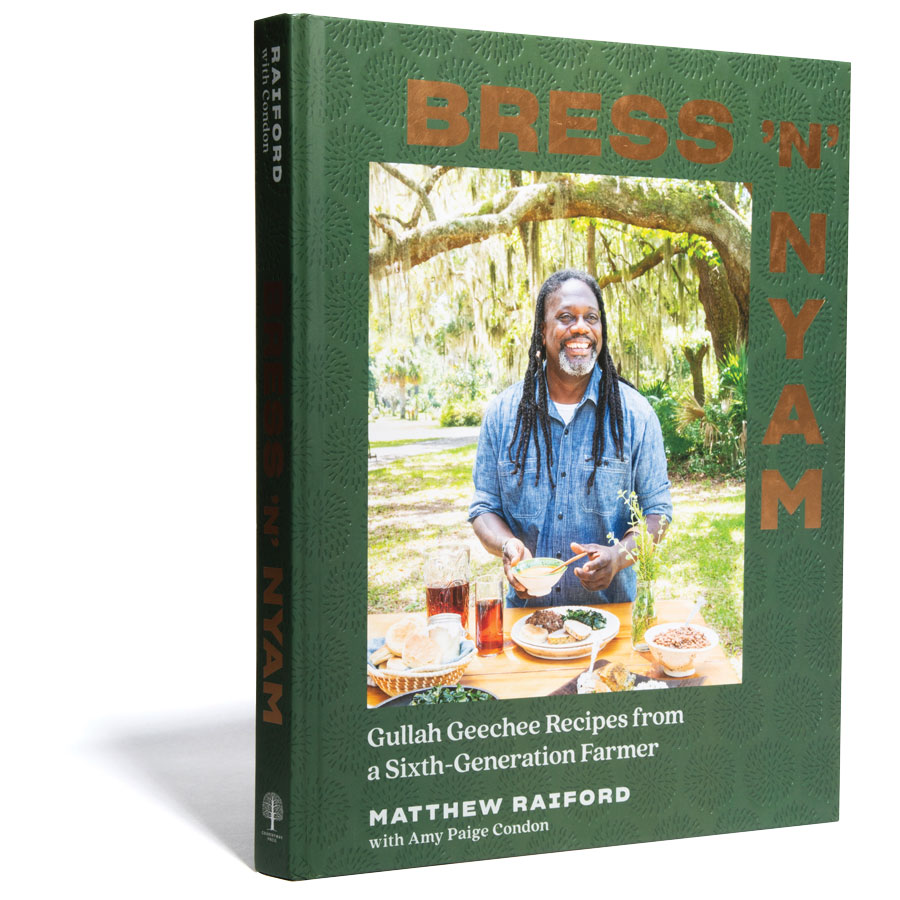
Photograph by Bailey Garrot; Food styling by D'Mytrek Brown; Prop styling by Jessica Bres
Gift-giving season—aka eating/drinking/baking season—has arrived. As the holidays approach, here are five beautiful new cookbooks from Georgia chefs, bakers, pitmasters, and farmers—plus recipes you can make from them.
 Cheryl Day’s Treasury of Southern Baking
Cheryl Day’s Treasury of Southern Baking
By Cheryl Day
That beautiful brown sugar pound cake at the top of this article? It’s from the best pastry shop in Savannah and probably one of the best in the state of Georgia: Back in the Day Bakery, owned by Cheryl Day and her husband, Griffith. You’ll have to travel there to taste the evidence in person, but, in the meantime, you can pick up a copy of Cheryl Day’s Treasury of Southern Baking, a compendious new guide to a regional art form.
Day’s pies are perfect, and her biscuits are legendary—and they’re all here. The book especially foregrounds the contributions of Black bakers, including Day’s own ancestors. Enslaved in Alabama, her great-great-grandmother Hannah Queen Grubbs was “well known to folks all across Dale County for making the tastiest buttermilk biscuits, sweet potato pies, lemon pound cakes, and coconut layer cakes,” Day writes: “It’s been said that history is written by the victors, and when it came to the recipe books from that era, they were written by white women who took credit for the creations of their Black cooks. I’m fortunate to have Hannah’s handwritten recipes to show me their true origins.”
Brown Sugar Spice Cake with Butterscotch Glaze
Serves 12
This cake could not be any simpler to make or more delicious to eat. It is rich and moist with a tender, delicate crumb. The aroma as it bakes will fill your kitchen with the scent of autumn. —Cheryl Day
For the Cake
2¼ cups (281 g) unbleached all-purpose flour
½ teaspoon (3 g) baking soda
½ teaspoon fine sea salt
½ teaspoon ground cardamom
¼ teaspoon ground mace
½ pound (2 sticks/227 g) unsalted butter, at room temperature
2 cups (400 g) packed light brown sugar
1 teaspoon pure vanilla extract
3 large (150 g) eggs, at room temperature
1 cup (240 g) sour cream
For the Butterscotch Glaze
7 tablespoons (99 g) unsalted butter
1 cup (200 g) packed light brown sugar
1 cup (237 ml) heavy cream
To make the cake Position a rack in the lower third of the oven and preheat the oven to 325 degrees F (165 degrees C). Butter a 10-inch (25 cm) Bundt pan, making sure to get into all the crevices. Lightly dust the pan with flour, tapping the pan on the counter to shake out the excess.
Sift together the flour, baking soda, salt, cardamom, and mace into a medium bowl; set aside.
In the bowl of a stand mixer fitted with the paddle attachment (or in a large mixing bowl, using a handheld mixer), cream the butter and brown sugar together on medium-low speed for 3 to 5 minutes, until light and fluffy. Add the vanilla and mix to combine. Add the eggs one (50 g) at a time, beating well after each addition. Add the flour mixture in thirds, alternating with the sour cream, beginning and ending with the flour and scraping down the sides and bottom of the bowl with a rubber spatula as necessary, then mix for about 1 minute, or until well blended.
Remove the bowl from the mixer stand (if using) and, using the spatula, incorporate any ingredients hiding at the bottom of the bowl, making sure the batter is completely mixed.
Pour the batter into the prepared pan. Tap the pan firmly on the countertop to remove any air bubbles from the batter. Bake for 60 to 75 minutes, until a cake tester inserted in the center of the cake comes out clean. Let the cake cool in the pan on a wire rack for 15 minutes, then invert onto another rack and turn right side up to cool completely.
To make the butterscotch glaze In a medium saucepan, combine the butter, brown sugar, and cream and cook over medium heat, stirring, until the sugar has completely dissolved. Then bring to a boil and cook until the glaze has thickened, about 5 minutes. Remove from the heat and let cool slightly.
Set the cake, still on the rack, on a baking sheet, and pour the glaze over the cake, letting it run down the sides.
The cake can be stored in an airtight container at room temperature for up to 3 days.
Excerpted from Cheryl Day’s Treasury of Southern Baking by Cheryl Day (Artisan Books). Copyright © 2021.
Bress ’n’ Nyam: Gullah Geechee Recipes from a Sixth-Generation Farmer
By Matthew Raiford with Amy Paige Condon
In the introduction to Bress ’n’ Nyam, Matthew Raiford describes his family history: He’s the great-great-great-grandson of Jupiter Gilliard, who was born into slavery in South Carolina in 1812 and, after Emancipation, assembled some 450 acres of farmland near Brunswick, Georgia. Some of that land is now owned by Raiford and his partner, Jovan Sage. Raiford, who graduated from the Culinary Institute of America in New York and has cooked all over the country, was a James Beard Award semifinalist for his work at his former Brunswick restaurant, the Farmer and the Larder. The title of the book is a Gullah Geechee saying that means “bless and eat.”
I am a little bit of a “from-ya” and a “come-ya,” meaning, in the Gullah Geechee context, someone from here and a visitor. But I am no longer passing through. I am the prodigal son who returned, only with my arms wide open for the land I thought I had left behind. Truth is, that old oak tree’s roots held on and never let me go. These acres are producing again, and not just food. They serve as fertile ground to teach sustainable farming techniques, like planting sunn hemp as a cover crop to attract butterflies, dragonflies, and bees—the essential pollinator—and to keep deer away from tomatoes, corn, peppers, peas, and sweet potatoes. The muscadine vines planted by my great-grandfather, Horace, still bloom with plump grapes for jellies and sweets. The herb garden is filled with plants that Jovan Sage, my partner and a true food alchemist, uses to create shrubs, tinctures, and spice blends that she sells on her website and through our cooking classes at the farm.
I have plans for more: rice fields and hothouses will be built, and the sugarcane press given to my great-grandparents as a wedding present in 1919 will soon run again. The other day, my cousin’s two-year-old son—the eighth generation of Jupiter Gilliard’s family to live on this land—wanted me to show him a heel-toe method for planting peas. He was loving it, just like I did as a kid. He’s learning where his food comes from, and that is important.
Effie’s Shrimp Creole
When folks think of coastal Georgia food, they think of shrimp and grits. That dish is definitely indicative of the Saltwater Gullah and Geechee who lived on the Sea Islands. They most often made the dish with a rich brown gravy or roux, much more akin to a gumbo. Freshwater—or mainland—Geechee, like my family, made something closer to a jambalaya, no okra but richly flavored with tomatoes and red pepper. The rice, of course, stretches it. For me, my mom’s shrimp creole, a recipe handed down through the family, is a comfort food. —Matthew Raiford
Serves 4
2 tablespoons unsalted butter
1 yellow onion, finely diced
3 garlic cloves, peeled and minced
1 green bell pepper, seeded and finely diced
1 red bell pepper, seeded and finely diced
1 orange bell pepper, seeded and finely diced
One 16-ounce can tomato puree
1 tablespoon red pepper flakes
2 cups uncooked long-grain rice or Carolina Gold rice
1 quart warm Shrimp Stock, prepared or homemade (recipe follows)
2 pounds large shrimp, peeled and deveined, shells reserved for Shrimp Stock
Fine sea salt and freshly ground black pepper
In a large cast-iron skillet, melt the butter over medium heat. Stir in the onions and garlic, and sauté until golden brown, about 5 minutes.
Add the peppers, tomato puree, red pepper flakes, and rice, stirring until well combined. Pour the stock in slowly to prevent splattering, as the pan will be hot, then bring the creole to a boil. Once boiling, stir, cover, then reduce the heat to low and simmer for 15 minutes.
Remove the cover, add the shrimp, and give the rice a good stir. Cook for 5 to 7 minutes more, until all the liquid is absorbed and the shrimp have pinked and curled. Before serving, taste and add salt and pepper to your liking. Serve and enjoy.
Shrimp Stock
Makes 2 quarts
2 quarts (8 cups) cold water
4 cups shrimp shells
1 tablespoon olive oil
1 Vidalia onion, peeled and quartered
1 carrot, roughly chopped
1 celery rib, cut into 2-inch pieces, including leaves
1 lemon, quartered
2 bay leaves
2 sprigs thyme
1 tablespoon kosher salt
1 teaspoon whole black peppercorns
Pour the water in a large stockpot and set aside.
Rinse and drain the shrimp shells. In a large skillet, heat the oil over medium-high heat and toss the shrimp shells for 2 minutes. Add the onions, carrots, and celery and cook, stirring, for 2 to 3 minutes more.
Add the shrimp shells and vegetables to the stockpot, then toss in the lemon, bay leaves, thyme, salt, and pepper. Bring the stock to a boil, then reduce heat and simmer for 40 minutes. Remove from the heat, then strain the stock through a cheesecloth-lined sieve into quart- or pint-sized containers. Cool the stock completely, then refrigerate for up to 2 weeks or freeze for later use.
Excerpted from Bress ’n’ Nyam: Gullah Geechee Recipes from a Sixth-Generation Farmer. Copyright © 2021 CheFarmer Matthew Raiford and Amy Paige Condon. Photography © 2021 by Siobhán Egan. Reproduced by permission of The Countryman Press, a Division of W.W. Norton & Company. All rights reserved.
The Twisted Soul Cookbook: Modern Soul Food with Global Flavors
By Deborah VanTrece
At her popular Blandtown restaurant, Twisted Soul Cookhouse & Pours, chef Deborah VanTrece deftly marries the soul-food flavors she knew from her youth with the wide range of culinary influences she gleaned in her former career as a flight attendant. Shifting professional gears in the 1990s, VanTrece attended culinary school—then, observing the often marginalized place of soul food in American cuisine, devoted herself to raising its profile.
As she writes in the introduction to The Twisted Soul Cookbook, “The soul food I knew—making a common cast-off, throwaway, disrespected food into something luxurious, tender, and tasty—stood apart from Southern food in many ways. The resounding belief in the Black community was, if the food looked good, it couldn’t taste good. I became motivated to think about how I could apply the techniques I had learned in culinary school to my food heritage. I knew soul food could both look good and taste good.” The evidence is everywhere in VanTrece’s new cookbook, like the lamb ribs with cucumber-tomato relish—where the inexpensive cut of meat gets a spicy kick from the North African spice blend harissa.

Photograph by Bailey Garrot; Food styling by D'Mytrek Brown; Prop styling by Jessica Bres
Harissa Lamb Ribs with Tomato-Cucumber Relish
Serves 8
Lamb ribs are often sold in stores as lamb breast. I discovered this affordable cut one day in the meat section at Walmart and have been creating dishes with them ever since. The meat is fatty, so slow cooking is required to render the fat, but it’s worth the time to reveal the full flavor and velvety texture of this cut. It is very similar to pork belly. Note that the final preparation includes grilling. The presence of spicy harissa adds a rich, gentle heat to the recipe. These ribs make a great appetizer or group starter and can be braised days in advance and finished on the grill just before serving. —Deborah VanTrece
Ribs
1 tablespoon kosher salt
¼ cup harissa powder, plus more for serving
1 tablespoon garlic powder
1 tablespoon onion powder
1 tablespoon ground cumin
½ teaspoon red pepper flakes
¾ cup fresh lemon juice (from about 3 lemons), divided
2½ to 3 pounds bone-in lamb ribs, trimmed of fat cap and scored
4 cups beef broth
1 carrot, coarsely chopped
1 celery stalk, coarsely chopped
5 cloves garlic, smashed
1 small onion, coarsely chopped
Tomato-Cucumber Relish
2 cups chopped fresh Roma tomatoes
1 cup coarsely chopped seedless English cucumber
½ cup chopped flat-leaf parsley
¼ cup chopped fresh mint
2 cloves garlic, minced
¼ cup red wine vinegar
¼ cup extra-virgin olive oil
½ teaspoon kosher salt
½ teaspoon freshly cracked black pepper
Make the ribs At least one day before you plan to grill, prepare the marinade. In a small bowl, stir together the salt, harissa, garlic powder, onion powder, cumin, red pepper flakes, and ½ cup of the lemon juice. Rub generously all over the lamb ribs to coat. Place the ribs in a resealable plastic bag and refrigerate for at least 24 hours or up to 2 days.
When you are ready to cook, preheat the oven to 325 degrees F.
Transfer the ribs to a roasting pan. Add the beef broth, carrots, celery, garlic, and onion to cover the ribs. Cover the baking pan tightly with foil and roast for 1 to 1½ hours, until the meat is tender.
Make the relish While ribs are in the oven, prepare the tomato-cucumber relish. In a medium bowl, combine the tomatoes, cucumbers, parsley, mint, garlic, vinegar, remaining ¼ cup lemon juice, the olive oil, salt, and pepper and toss to mix. Cover the bowl with plastic wrap and refrigerate until ready to serve.
When ready to serve, transfer the cooked ribs to a platter or sheet pan to cool.
Pour the remaining broth into a medium saucepan and cook over medium heat for 30 to 45 minutes, stirring occasionally, until the liquid is reduced by half.
Prepare your grill for direct heat, or preheat a gas grill to 400 degrees F. Place the ribs on the grill and cook for 4 to 5 minutes, until slightly charred, then turn the ribs and grill the other side for 4 minutes to brown. Brush the ribs with the reduced broth and transfer to a cutting board. Let them rest for 5 minutes, then slice the ribs. Brush the ribs again with the reduced broth and sprinkle with a little more harissa before serving. Serve the ribs with the chilled tomato-cucumber relish.
© The Twisted Soul Cookbook: Modern Soul Food with Global Flavors by Deborah VanTrece, Rizzoli New York, 2021.
 Rodney Scott’s World of BBQ: Every Day Is a Good Day
Rodney Scott’s World of BBQ: Every Day Is a Good Day
By Rodney Scott and Lolis Eric Elie
Rodney Scott first gained fame in his home state of South Carolina, but he’s newly an Atlanta restaurateur, too, with a congenial spot that opened in July in Adair Park. His literary debut, is, of course, a cookbook. But it’s also a tools and construction manual, with explanations on everything from what kind of mop to use when swabbing the hog (rayon, please; cotton breaks down when dipped in a vinegar-based sauce) to how to build a real-deal barbecue pit (start by collecting 62 cinder blocks and seven lengths of rebar) to—and this is important—how to mix a great drink, like the gin-based Red Pickup cocktail pictured above, to go with it all. The instructions are detailed, helpfully photographed—and not a little poetic.
Building a pit is a commitment. Between the shopping for materials and the actual construction of the pit, you’re talking a few hours. And that’s before you spend the twelve hours cooking the hog. Needless to say, I think it’s worth it. And once you build your first pit and cook your first hog, you will, too. On one hand the pit is a necessary piece of equipment. You can’t really cook a whole hog without one. On the other hand, it’s much more than that. The pit becomes the centerpiece for a gathering. If it’s a little cold outside, people congregate around the pit for the warmth and fellowship. Even if it’s not cold, I think we all have a little fascination with fire. The idea of controlling and using something that can be so powerful and so destructive is almost like a drug. Even looking at how the embers still glow long after you pull the pig off is kind of beautiful.

Photograph by Bailey Garrot
Red Pickup Cocktail
Makes 1 cocktail
When I have an important call and I don’t want to be distracted by customers or staff, I walk out of the restaurant and take the call in my red pickup. When I have to check on the progress of our restaurants in Birmingham and Atlanta, I’d rather hop in my red pickup than hop on a plane. When I need to clear my head, I jump into my red pickup, play my music, and take a drive to nowhere in particular. This is my red pickup in a glass. —Rodney Scott
¾ ounce fresh lime juice
½ ounce cranberry juice
½ ounce Ruby Red grapefruit juice
¾ ounce simple syrup (below)
¼ ounce Campari
¼ ounce cachaça (preferably Avuá Prata)
½ ounce Lillet Blanc
1¼ ounces gin (preferably Hat Trick Botanical Gin)
Crushed ice (see tip)
Ice cubes
Lime wheel, for garnish
In a cocktail shaker, combine the lime juice, cranberry juice, grapefruit juice, simple syrup, Campari, cachaça, Lillet, and gin. Sprinkle a small handful of crushed ice into the shaker, cover, and shake vigorously for 10 to 15 seconds. Strain into a tall ice-filled glass. Garnish with a lime wheel on the rim of the glass.
Rodney’s pro tip To make crushed ice, place ice cubes in a plastic bag and smash it with a heavy-bottomed pot.
Simple syrup Simple syrup is just that: simple. Equal parts water and sugar cooked into a syrup. To make it, in a saucepan, bring the water to a boil and add the sugar. Stir until the sugar is dissolved. Turn off the heat and set aside to cool. Once the syrup is at room temperature, refrigerate until thoroughly chilled. Simple syrup can be refrigerated for up to 3 weeks.
Reprinted with permission from Rodney Scott’s World of BBQ: Every Day Is a Good Day by Rodney Scott and Lolis Eric Elie. Copyright © 2021 by Rodney Scott’s BBQ, LLC, a South Carolina limited liability company. Photographs copyright © 2021 by Jerrelle Guy. Published by Clarkson Potter, an imprint of Penguin Random House.
 Black, White, and the Grey: The Story of an Unexpected Friendship and a Beloved Restaurant
Black, White, and the Grey: The Story of an Unexpected Friendship and a Beloved Restaurant
By Mashama Bailey and John O. Morisano
Black, White, and the Grey unfolds as a kind of joint memoir, authored by Morisano—a white entrepreneur who purchased a former Greyhound terminal in Savannah—and Bailey, the Black chef he brought on to be his partner. The pair turned the old bus station into a restaurant, the Grey, that opened in 2014 to near universal acclaim. Their book—mostly prose, with a few well-chosen recipes—explores the tensions and triumphs of that relationship; it’s written in a dialogic style, with the parts authored by Bailey in bold text. Here, early in their partnership, they’re touring the husk of the building, which dates to 1938. Its architecture bears the gorgeous Art Deco flourishes of the period—as well as reminders of its former status as a racially segregated facility.
We walked back upstairs and then up another flight to a grand space (by the era’s standards) on the mezzanine level. Graffiti-covered mint-green tiles lined the way and encased two rooms at the top of the staircase. As we entered the first, I said, “This was the White women’s powder room and bathroom.” Pointing at the first wall we encountered, “This was mirrored and had a counter and chairs so that women could fix their makeup.”
“White women,” Mashama said pointedly.
“Yeah. White women,” I mumbled.
Entering the second room just behind the first, “This is where the toilets were. If you look at the floor, you can make out the outlines of the stalls and where the sewage lines were.”
Mashama, her face expressionless, noted, “White women sure needed a lot of room to pee.”
I was amazed by the intention behind it. The beautiful green tiles that lined the walls, the gorgeous light pouring in through the windows, these women were on top of the world, I remember thinking to myself. This room suddenly represented to me White women being put on a pedestal, peeing above everyone who was allowed into the bus station.
This was the deification of White women. Those women being such a prize that, if Black men tried to “possess” it, their murders were easily justifiable by their White counterparts. Emmett Till being a prime example—and he was just fourteen years old.
Back down on the main floor, we crossed a threshold into a small five-by-ten-foot space near the rear entry.
“This is where the colored folks waited, right?” she asked me.
“Yeah, this was the colored waiting room, and back in here, the two little bathrooms were the colored his and her restrooms.”
That space was as big as any apartment I’d ever lived in. But, compared to the 24-hour diner in front, the ladies’ room upstairs, the men’s room downstairs, and the large waiting room, this area was tiny. I was excited to see this space, and, as I stood there, I thought that I would feel sad or humiliated after I had seen all of the other parts of the building that I would not have been allowed into. I mostly felt pride, though, because there was a very strong chance that I would have an opportunity to alter the building’s historic narrative by possibly being a partner in the next business that would occupy it, adding an element of hope to a changing city.
Braised Cabbage with Tomatoes and Fish Sauce
Serves 4
We often talk about the braised eel and cabbage we ate in Comacchio, Italy, and wanted to include that recipe in this book. But we wondered, Where in the hell are people going to get eel? Mashama is like the MacGyver of cooks, so she decided that we’d give you a recipe that mimics the flavors of that dish with ingredients that are a lot easier to find. —John O. Morisano
½ cup extra-virgin olive oil
1 large yellow onion, thinly sliced
6 cloves garlic, sliced
1 head Savoy cabbage, shredded
1 (28-ounce) can San Marzano tomatoes
Kosher salt
Freshly cracked black pepper
1 teaspoon smoked paprika
¼ cup Colatura di Alici fish sauce (you can buy it online)
In a large sauté pan, heat the olive oil over medium heat and then add the onion and garlic. Cook for 4 minutes. Add the cabbage and tomatoes to the pan, crushing each tomato with your hand. Dump the tomato liquid from the can into the pan as well, season with salt and pepper, cover, and braise for 30 minutes. Stir the paprika into the cabbage mixture. Remove from the heat and stir in the fish sauce. Transfer to a serving bowl and have at it.
Reprinted with permission from Black, White, and the Grey by Mashama Bailey and John O. Morisano, copyright © 2021. Published by Lorena Jones Books, a division of Penguin Random House, LLC.
This article appears in our November 2021 issue.











![The North Carolina Museum of Natural Sciences’ newest exhibit is a [pre]historic first](https://cdn2.atlantamagazine.com/wp-content/uploads/sites/4/2024/04/DD-3-100x70.jpg)



